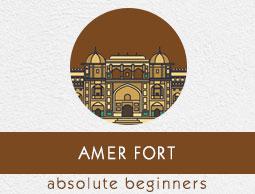Amer Fort - Quick Guide
Amer Fort - Overview
Amer Fort is situated in a town called Amer which is located at around 11km from Jaipur. The fort is built on Hindu architectural background having gates, temples, palaces, and other structures. For providing water inside the fort, there is a Maota Lake nearby. The materials used in the construction of the fort are marble and red sandstone. The fort is also known as Amer Palace due to the presence of temples and gardens. The wives of Rajput kings used to live in the palace.

Jaipur
Amer Fort is situated in Jaipur which is the capital of Rajasthan state in India. Maharaja Jai Singh II founded the city in 1726. Jaipur is very popular from tourism point of view due to the presence of forts, palaces, temples and many other monuments. Besides Amer Fort, people can visit Hawa Mahal, City Palace, Jantar Mantar, Nahargarh Fort, Jaigarh Fort, Birla Mandir and many others.
Visiting Hours
The fort is opened for the public from 8am to 6pm. Tourists can also enjoy light shows in English and Hindi. The show in English starts at 7:30pm whereas in Hindi, it starts at 8pm. The fort is opened on all seven days.
Tickets
The tourists can buy tickets from the ticket counters to visit the fort. For Indian tourists, the ticket for an adult is Rs. 24 and for a student it is Rs. 10. For foreigner tourists, the ticket for an adult is Rs. 200 and for student it is Rs. 100. The cost of ticket for light show in English is Rs. 200 and for show in Hindi it is Rs. 100. Tourists can also visit the fort on an elephant. Only two people are allowed to sit on the elephant and the cost is Rs. 900.
Composite Tickets
Tourists can also purchase composite tickets with which they can visit five monuments which are Amer Fort, Jantar Mantar, Hawa Mahal, Albert Hall Museum, and Nahargarh Fort. The tourists can buy the ticket from the premises of Amer Fort, Albert Hall, Hawa Mahal, and Jantar Mantar. The cost of composite ticket for Indian is Rs. 150 and for foreigners it is Rs. 300. The ticket is valid for two days only.
Free Days
There are a few days on which visitors can visit all the monuments free of cost. These days are as follows −
Rajasthan Day − Rajasthan was formed as a state on 30th March 1949 and so the day is celebrated as Rajasthan Day. Many events are organized on the day and it is celebrated all over Rajasthan.
World Heritage Day − World Heritage day is a day in which awareness is created among the public to protect the historical monuments. The first World Heritage day was celebrated on 18th April 1982. Many events are organized all over the world which includes exhibitions, photography competitions, award ceremonies, and many others.
World Museum Day − The celebration of World Museum Day was started on 18th May 1977. The day is celebrated to create awareness among the people about the importance of museums.
World Tourism Day − The celebration of World Tourism Day was started on 27th September 1980. The reason behind celebrating the day is that Statutes of UNWTO were adopted on this day in 1970. The day is celebrated to create awareness among people about importance of tourism.
Best time to Visit
The best time to visit Jaipur is February to April and October to December. The climate is pleasant in these months as these months are neither very hot nor very cold. Rest of the months are not suitable as Jaipur has three climates, hot summers, cold winters, and monsoon.
Amer Fort - History
Amer under Meenas
Amer Fort is situated in the Amer town which is at the distance of 11 km from Jaipur. The Amer town was firstly occupied and administered by Meenas. As they worshipped Goddess Amba, so on that basis they named the place as Amer or Amber. Goddess Amba was also known as Gatta Rani or Queen of Pass. History says that Amer town was previously known as Khogong which was ruled by Raja Ratun Singh or Alan Singh Chanda.
Amer under Kachwahas
Kachwahas are said to be the descendants of Kush, the second son of Lord Rama. One of the descendants of Kush was Raja Nal who settled in Nurwar. Raja Sora Singh was the descendant of Raja Nal who was killed and his son Dhola Rae was deprived of inheritance.
As Dhola Rae was an infant, his mother felt that the usurper may kill her and the child so she put the child in a basket and reached near Khogong which was ruled by Meenas. Being hungry she was plucking wild berries. Seeing a snake near the basket she screamed but a Brahmin saw and told that the baby has a very bright future.
He took her to Khogong where she asked the king to give her some employment for survival. The queen included her in her slaves. One day, as per the order, she cooked food which was liked by the king. When he listened her story, he adopted her as sister and Dhola Rae as his nephew. Dhola Rae was sent to Delhi at the age of 14 and he returned after five years.
The Kachwaha Rajputs returned with Dhola Rae and as per their conspiracy, they killed many of the royal people and the public during the celebration of Diwali festival. In this way, the Kachwahas overtook the town from the Meenas. The first king of the Kachwahas was Raja Kakil Dev who made Amer town his capital in 1036AD. The construction of the fort was started by Raja Man Singh in 967AD and was expanded by Raja Jai Singh I. The fort was improved by many other rulers who succeeded Jai Singh I. Jai Singh II shifted his capital from Amer town to Jaipur.
Raja Jai Singh I and II
Jai Singh I and Man Singh started the construction of Amer Fort. Jai Singh I also was the commanding officer of Mughal army and fought many battles for Jahangir, Shah Jahan, and Aurungzeb. After Jai Singh I, three more rulers succeeded him. After that Raja Jai Singh II succeeded and he also impressed Aurungzeb. Due to this, Aurungzeb gave him the title of Sawai which means one and a quarter.

Since he has close bonds with the Mughals, so he started the construction of his dream city Jaipur with the help of Vidyadhar Bhattacharya. The city was divided into seven blocks having buildings and trees. There were high walls having ten gates to enter the city. The placement of shops was divided into nine sectors called chokris.
Structures inside Amer Fort
The structures built by the Meenas were demolished by the Kachwahas to make their structures. The fort includes halls, palaces, temples, and many other structures. People can reach the fort through their vehicles or they can ride elephants for the purpose.
Amer Fort - Architecture & Design
There are four divisions of the Amer fort and each division is known as courtyard. All the sections have a gate to make an entry. The main entrance of the fort is through Suraj Pol or Sun Gate as it faces east. Sawai Jai Singh II built this gate.
First Courtyard
The first courtyard is called Jalebi Chowk or Jaleb Chowk. Here the armies held victory parades under the commander called Fauj Bakshi and Royal families view it. There were stables for horses and rooms for the soldiers.
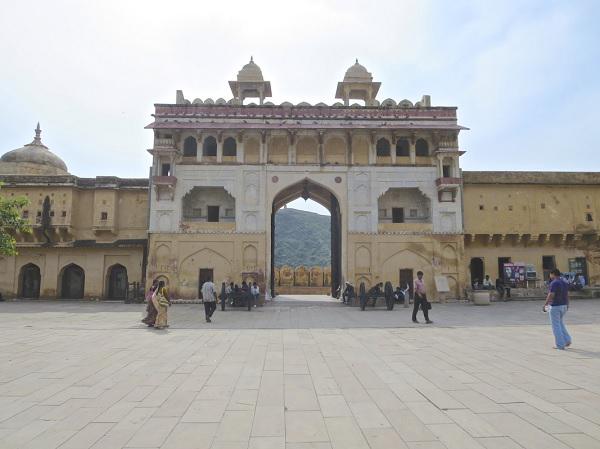
Ganesh Pol is another gate which led to the palaces of maharajas. There is a Suhag Mandir above the gate where royal ladies used to worship.
Sila Devi Temple
Sila Devi Temple is situated on the right side of Jalebi Chowk. Legends say that Sila Devi was the incarnation of Goddess Kali. There is a double door entrance to the temple covered with silver. The deity is surrounded by two lions one on left and one on right and both lions are also covered with silver. The entrance has a carving of Lord Ganesh which is made up of single piece of coral.
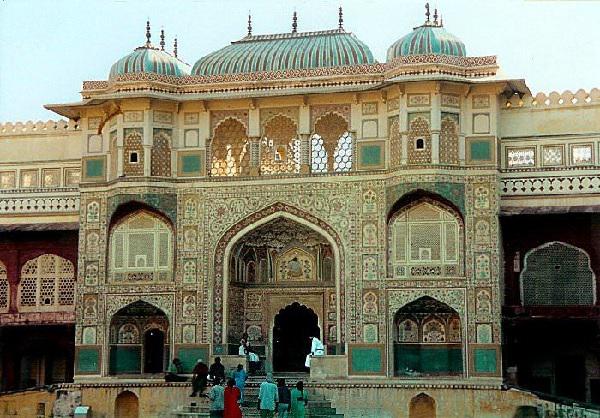
Animal sacrifice was a trend during Navratri in which buffaloes and goats were sacrificed on the eighth day. The sacrifice was given in front of the royal families and the devotees used to watch. This practice was banned in 1975 and sacrifice was done only in front of royal people. The sacrifice is totally banned now and only vegetarian food is offered to the goddess.
Second Courtyard
There is a stairway from the first courtyard which leads to second courtyard where Diwan-e-Aam or the public hall was constructed. There are 27 evenly divided columns situated on a raised platform each having an elephant-shaped capital.

Diwan-e-Khas was also located here for the meetings of king with people of the court, ambassadors, and other royal guests.

Third Courtyard
The tourists can enter the third courtyard through Ganesh Pol. This was the courtyard where royal families and their attendants used to live. Ganesh Pol is covered with mosaic and there are many sculptures engraved on it. Jai Mandir and Sukh Niwas are the two buildings constructed on this courtyard. Between these two buildings there is a garden built in the same way as Mughal Gardens.
Jai Mandir
Jai Mandir has ceilings with convex-shaped multiple mirrors. These mirrors are made colourful so that they can glitter due to candle light at night. That’s the reason that Jai Mandir is also known as Sheesh Mahal built by Raja Man Singh which was completed in 1727.

Sukh Niwas
Sukh Niwas is also known as Sukh Mahal whose entrance is a sandalwood door. The palace was made cool through pipes with water supply which produced an air-conditioned environment.

The Sukh Niwas has a magic flower which is a marble panel carved on a pillar. The seven designs on the flower are
- fish tail
- hooded cobra
- lion’s tail
- scorpion
- lotus
- elephant trunk
- cob of corn
Tourists cannot see the designs at a glance. They have to partially hide the panel in order to see the designs.
Man Singh I Palace
Man Singh I Palace was completed in 1599 during the reign of Man Singh I. It took around 25 years to build the palace. There is a pavilion in the centre of the palace called baradari. Along with this, there are colourful tiles for decorating the rooms. There are small rooms surrounding the pavilion each having a balcony.
Garden
The garden was built by Raja Jai Singh I who ruled from 1623 to 1668. The construction of the garden was based upon the Mughal garden. The garden is made in hexagonal shape and is placed between the Jai Mandir and Sukh Niwas. There is a star-shaped pool with a fountain at the centre.

The garden was watered from the channels of Sukh Niwas and channels from the roof of Jai Mandir. The channels that originated from Jai Mandir were called Chini Khana Niches.
Tripolia Gate
Tripolia Gate is a gate which provides entrance to the fort from the west. Since the door opens in three directions, it is called tripolia gate. The three directions include Jalebi Chowk, Man Singh Palace, and Zenana Deorhi.
Lion Gate
The lion gate or singh pol led to the private apartments in the fort premises. The gate was named so because of its strength. The gate has frescoes on its outer side. The gate was guarded by the defenders so that the invaders could not reach the palaces.
Fourth Courtyard
This is the courtyard in which royal ladies and their attendants resided. There were many rooms for the mother and wives of the king. The rooms were designed in such a way that when a king chooses to live with one of his wives, other wives do not come to know about it.
Jas Mandir
Jas Mandir is situated in the fourth courtyard for royal women to worship. The temple has floral glass inlays. The temple was built on the upper part of diwan-e-khas. The floral designs with glass in them were used to decorate the temple. These glasses were imported from Belgium.
Amer Fort - How to Reach?
Jaipur is connected various cities by air, rail, and road transport. Some of the nearby cities with their distance from Jaipur are as follows −
Jaipur to Ajmer
By road – 134km
By rail – 92km
By air – 121km
Jaipur to Jodhpur
By road – 337km
By rail – 311km
By air – 282km
Jaipur to Jaisalmer
By road – 568km
By rail – 665km
By air – 481km
Jaipur to Bikaner
By road – 336km
By rail – 345km
By air – 272km
Jaipur to Delhi
By road – 268km
By rail – 288km
By air – 241km
Jaipur to Lucknow
By road – 571km
By rail – 559km
By air – 514km
Jaipur to Agra
By road – 242km
By rail – 228km
By air – 222km
Jaipur to Ahmedabad
By road – 664km
By rail – 620km
By air – 534km
By Air
Jaipur is connected to various major cities by air as the city has its airport at Sanganer which is 12 km away from the city. International and domestic flights land here. The airlines whose national and international flights land in Jaipur are Jet Airways, Air India, Oman Air, SpiceJet, and IndiGo.
By Rail
Jaipur is connected to various cities in India through trains. Many long and short-distance train start, end, or pass through Jaipur. Premium trains like Shatabdi, Rajdhani, Duronto, Double Decker, Garib Rath trains connect Jaipur to various cities.
Many superfast trains and fast mail and express trains also pass through Jaipur. The main railway stations of Jaipur are Jaipur Junction, Jaipur Gandhinagar, Getor Jagatpura, and Durgapura.
By Road
Jaipur is connected to many cities through a network of national highways. Bus services are provided by Rajasthan State Road Transport Corporation (RSRTC) to go to and come from Delhi, Agra, Ahmedabad, Ajmer, Udaipur and many other cities. The tourists can get both AC and non-AC buses for various routes. The buses can be boarded from Sindhi Camp bus stand.
Local Transport
In order to visit various places in Jaipur, tourists can get the facility of prepaid taxis which they can get from railway stations and airport. Cycle-rickshaw and three-wheelers are also available to go to the places at short distance. Besides these, local mini-buses, and AC and non-AC low-floor buses are also available.
Where to Stay?
There are around 933 hotels in Jaipur which include inexpensive budget hotels to expensive five-star hotels. Tourists can stay in any of these hotels according to their budget. The facilities in budget hotels are less in comparison to star hotels but still they provide good accommodation and food facilities.
Amer Fort - Nearby Places
There are many places nearby Amer Fort which the people can visit and get to know the history about those places. The places nearby Amer Fort are Jaigarh Fort, Nahargarh Fort, Jagat Shiromani Ji Temple, Panna Meena ka Kund etc.
Jaigarh Fort
Jaigarh Fort is situated nearby Amer Fort and Maota Lake. Sawai Jai Singh II built the fort in 1726 in order to protect the Amer fort. The fort is also known as Victory Fort and is situated at the high hill whose name is Cheel ka Teela or Hill of Eagles.
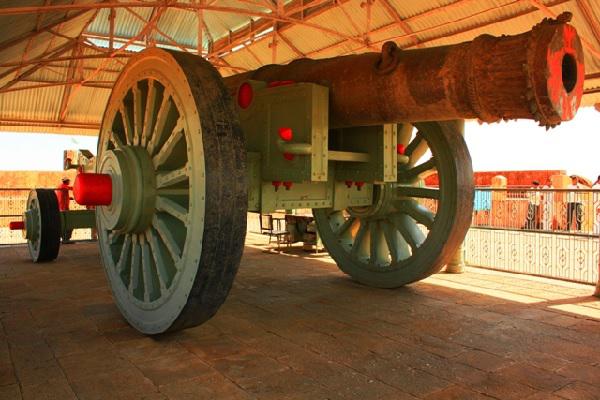
The fort has a length of 3km and width of 1km. The distance between Amer Fort and Jaigarh Fort is 0.2km.
Nahargarh Fort
Nahargarh Fort was also built to protect the Amer Fort. Previously its name was Sudarshangarh which later changed to Nahargarh which means abode of tigers.

The fort was built by Sawai Jai Singh II in 1734. Sawai Ram Singh extended the fort in 1868 while Sawai Madho Singh built many palaces between 1883 and 1892.
Jagat Shiromani Temple
Jagat Shiromani Temple is situated in Amer where Meera Bai, Sri Krishna, and Lord Vishnu are worshipped. Queen Kankawati was the wife of Raja Man Singh I and she built this temple between 1599 and 1608 AD. The distance between the temple and Amer Fort is 0.4km.

Panna Meena ka Kund
Panna Meena ka Kund also known as Panna Mian ki Baori or Panna Mian ka Kund. It is located at the distance of 0.6km from Amer Fort. The kund is located near Anokhi Museum.
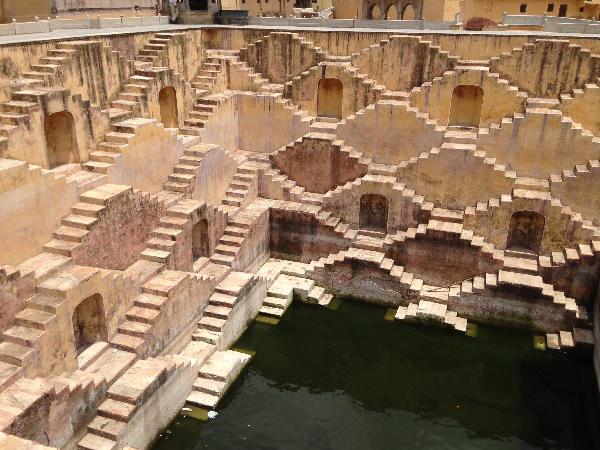
It was built in 16th century for the people to swim and to relax. As the ground remained cool during summer, people came here during summer specially in afternoon.
Jal Mahal
Jal Mahal is located in the middle of the Man Sagar Lake which is around 1.9km from Amer. Raja Jai Singh II built the palace in 18th century for his residence. The construction includes both Rajput and Mughal architecture.

Tourists have to use a boat in order to reach the Jal Mahal. Red sandstone is used to build the five-storey palace. Its restoration has been taken up by Rajasthan Government.


